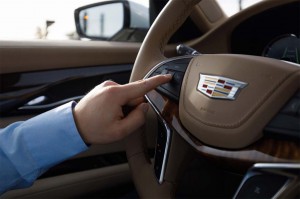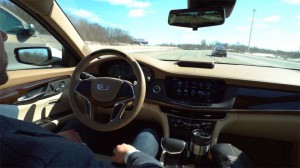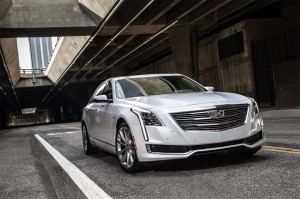Come the 2018 model-year, Cadillac CT6 buyers will be able to press a button on their steering wheel and then slip back and relax.
The automaker has finally set a date to launch its long-awaited Super Cruise system, a significant step along the path towards autonomous driving. Somewhat similar to Tesla’s Autopilot, the Caddy technology takes existing technologies like active cruise control and automatic braking a step further, allowing the vehicle to steer itself when operated on well-marked roads.
But buyers be advised: you won’t be able to switch on Super Cruise during your morning commute and then stretch out for a quick catnap on the way to work. The system monitors driver behavior to ensure that a human can quickly regain control in the event of a problem. If need be, the system will come to a complete stop and call for help.
Automakers around the world are racing to see who can come up with more sophisticated safety and convenience systems as a prelude to an era of fully autonomous, and even driverless, vehicles. Several manufacturers now offer some degree of hands-free operation, including Mercedes-Benz, BMW and Volvo, as well as Tesla. Now, Cadillac is in the hunt.

A tap of the button turns Super Cruise on. But a camera on the wheel also makes sure the motorist is alert and ready to retake control.
“Super Cruise is a more technologically advanced hands-free driving solution, which in terms of capability, integration and validation is uniquely focused on customer convenience and safety,” claimed Johan de Nysschen, Cadillac president, in a statement announcing the technology’s fall 2017 debut. “Cadillac’s philosophy is to elevate driving. Super Cruise enables safe, simple hands-free driving for the highway.”
(By 2030, study predicts 1/4 of all miles driven in the U.S. will be in ride-sharing, driverless battery vehicles. Click Here for the story.)
Like other semi-autonomous systems, Super Cruise will use a mix of sensors, including cameras and radar, as well as conventional GPS. But the Cadillac system goes a step further, adding highly precise, 3D maps created ahead of time using a laser-based system called LIDAR. (But unlike prototype autonomous vehicles being tested by GM, Ford, Google’s Waymo and others, there are no LIDAR sensors on the CT6 itself, those devices currently costing as much as $75,000 apiece.)
All together, this sensor fusion allows Super Cruise to operate in hands-off mode where there are “appropriate road conditions.” That generally requires divided highways with good markings for the system to follow, along with clear on and off-ramps.
One of the pieces Super Cruise adds to the equation is a camera atop the steering column that is constantly watching the driver. This system is not completely driverless; a motorist must be at the ready to take back control at a moment’s notice. This camera watches a driver’s head motions and if it senses the driver is distracted long enough it will initiate a series of escalating alerts, starting with lights on the steering wheel and then vibrating the driver’s seat. Eventually, it will bring the CT6 to a full stop and use OnStar to call authorities.
“When we were developing Super Cruise we knew it was important to keep the driver engaged during operation. That’s why we’ve added a driver attention function, to insist on driver supervision,” said Barry Walkup, chief engineer of Cadillac Super Cruise.”
Eleven months ago a former Navy SEAL was killed in a crash of a Tesla Model S using Autopilot. While it appears the system didn’t recognize a truck turning in front of the vehicle, a federal investigation ultimately determined the driver was distracted, likely watching videos on a laptop computer, and failed to react to the emergency.
Tesla has since updated its system but, last month, a Model X was involved in a low-speed incident when it ran into a police motorcycle at a stoplight. Specific causes have not yet been determined.
(Waymo and Bosch team up to put driverless robo-cabs on the road by 2021. Click Here for more.)
Those and other recent crashes have led some observers to question just how fast the industry will be able to reach full autonomy. Some automakers, including Tesla and Nissan, hope to have vehicles in showrooms by the end of the decade capable of full hands-free driving on all roads – though they would still need a back-up “operator” at the ready. Others, including Ford and Daimler, believe they can launch fully driverless vehicles, without even steering wheels and pedals, as early as 2021 – though they initially plan to target ride-sharing and delivery fleets.
GM was named one of the five leaders in the emergency field of self-driving cars in a new study released this month by Navigant Research. A key reason why the Detroit maker, cross-town rival Ford, Daimler and Renault-Nissan were hailed as leaders is that they have all outlined what the study called “pathways to production.”
(For more on the new Navigant study, Click Here.)


